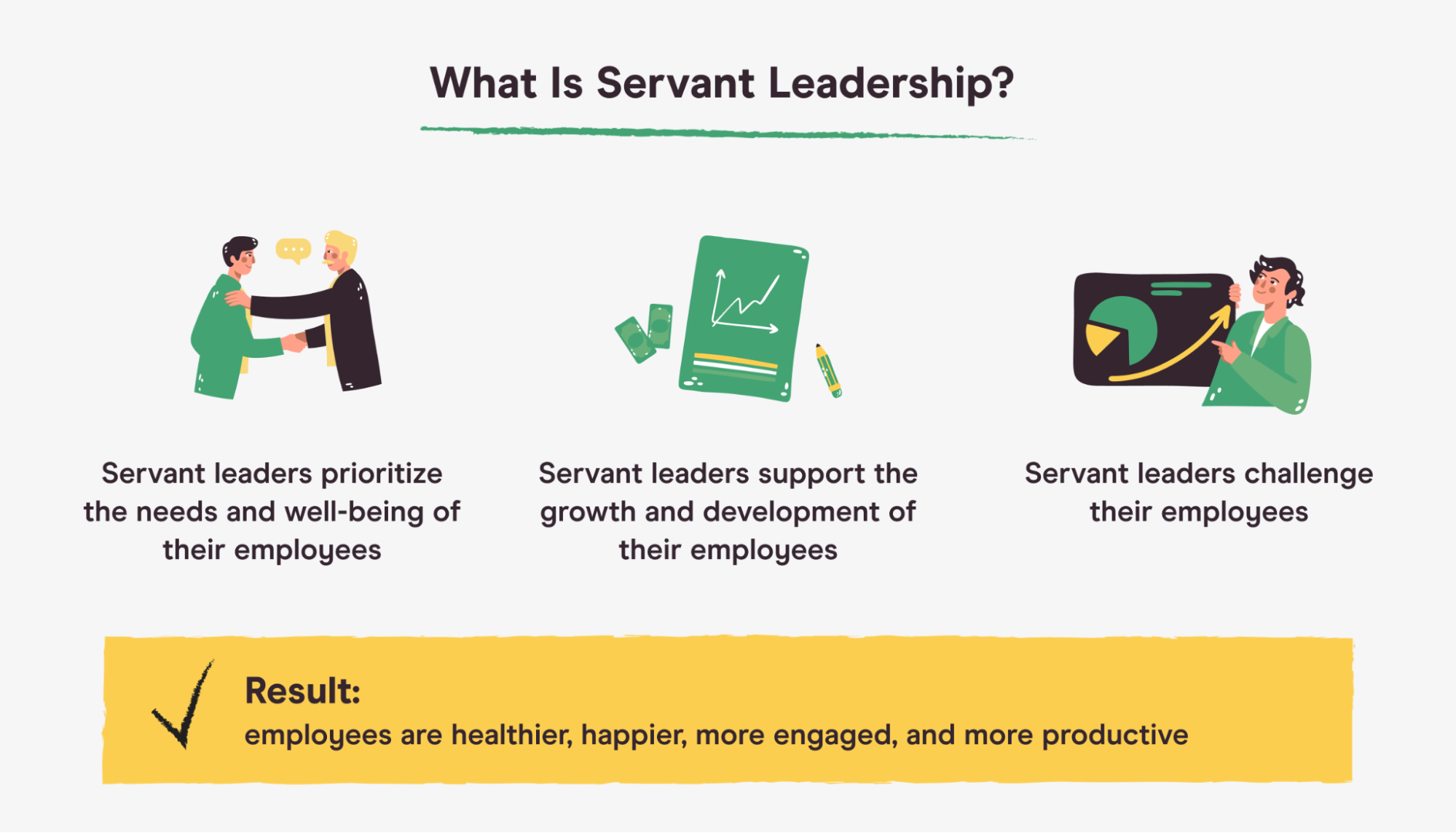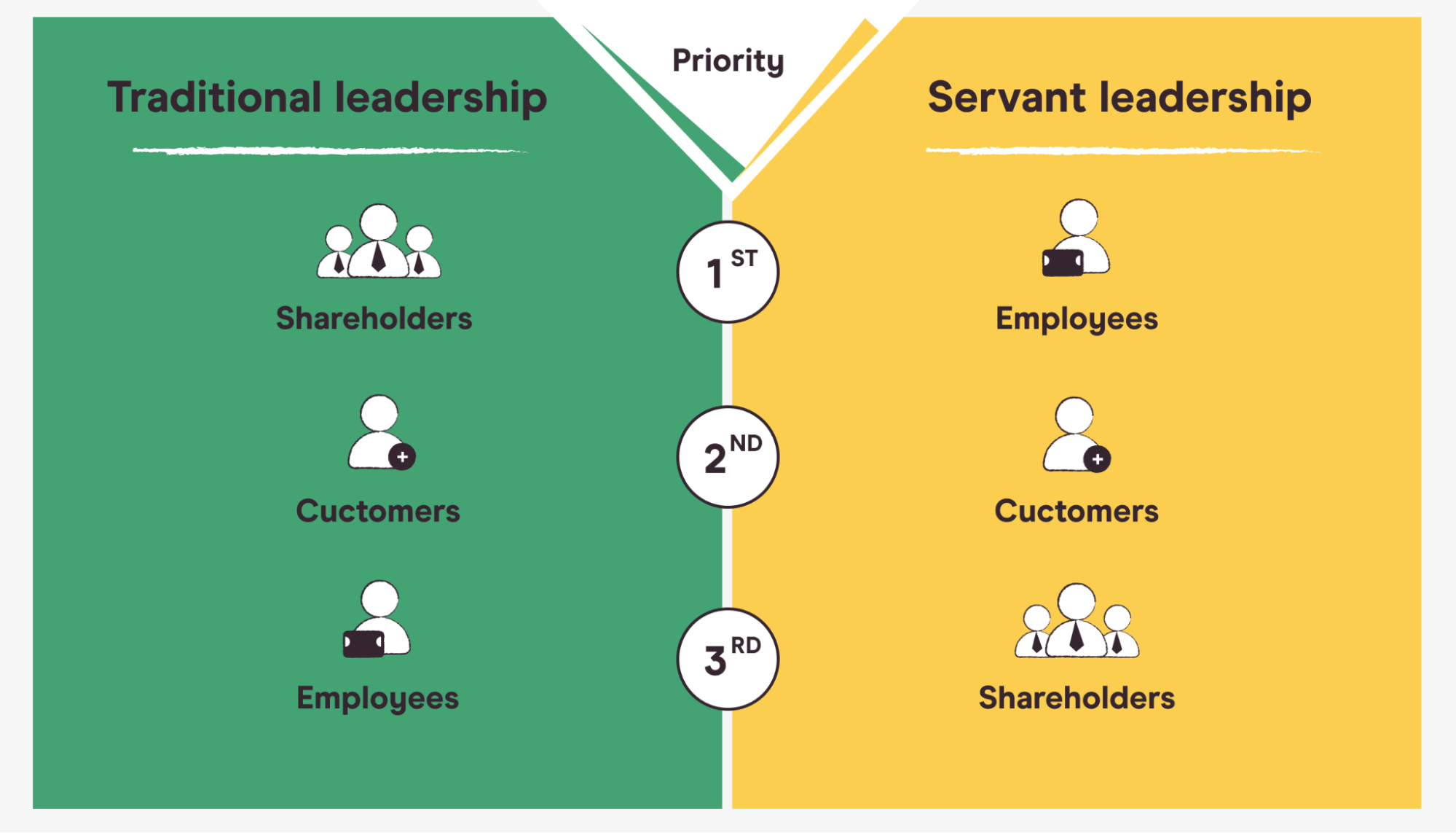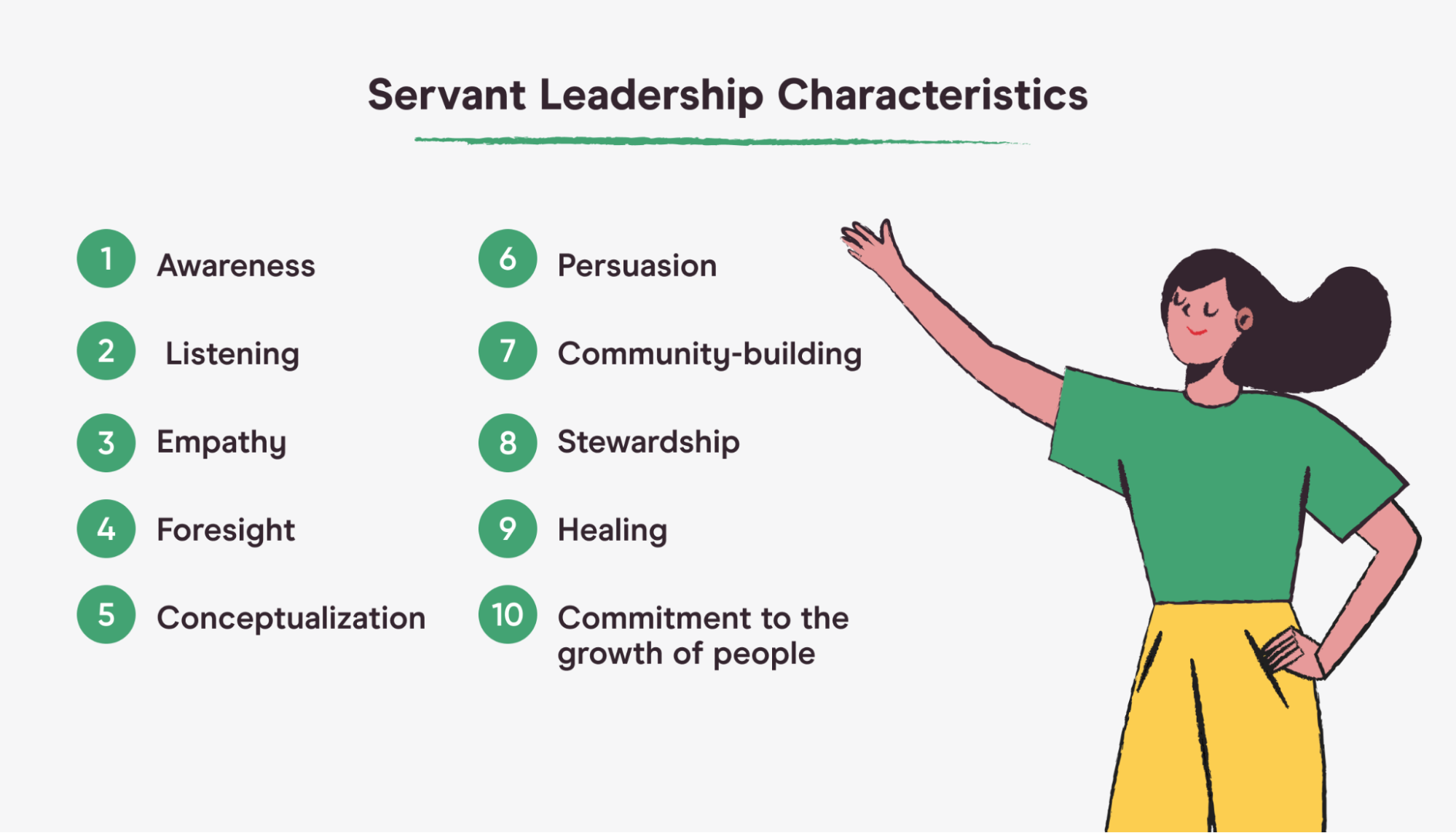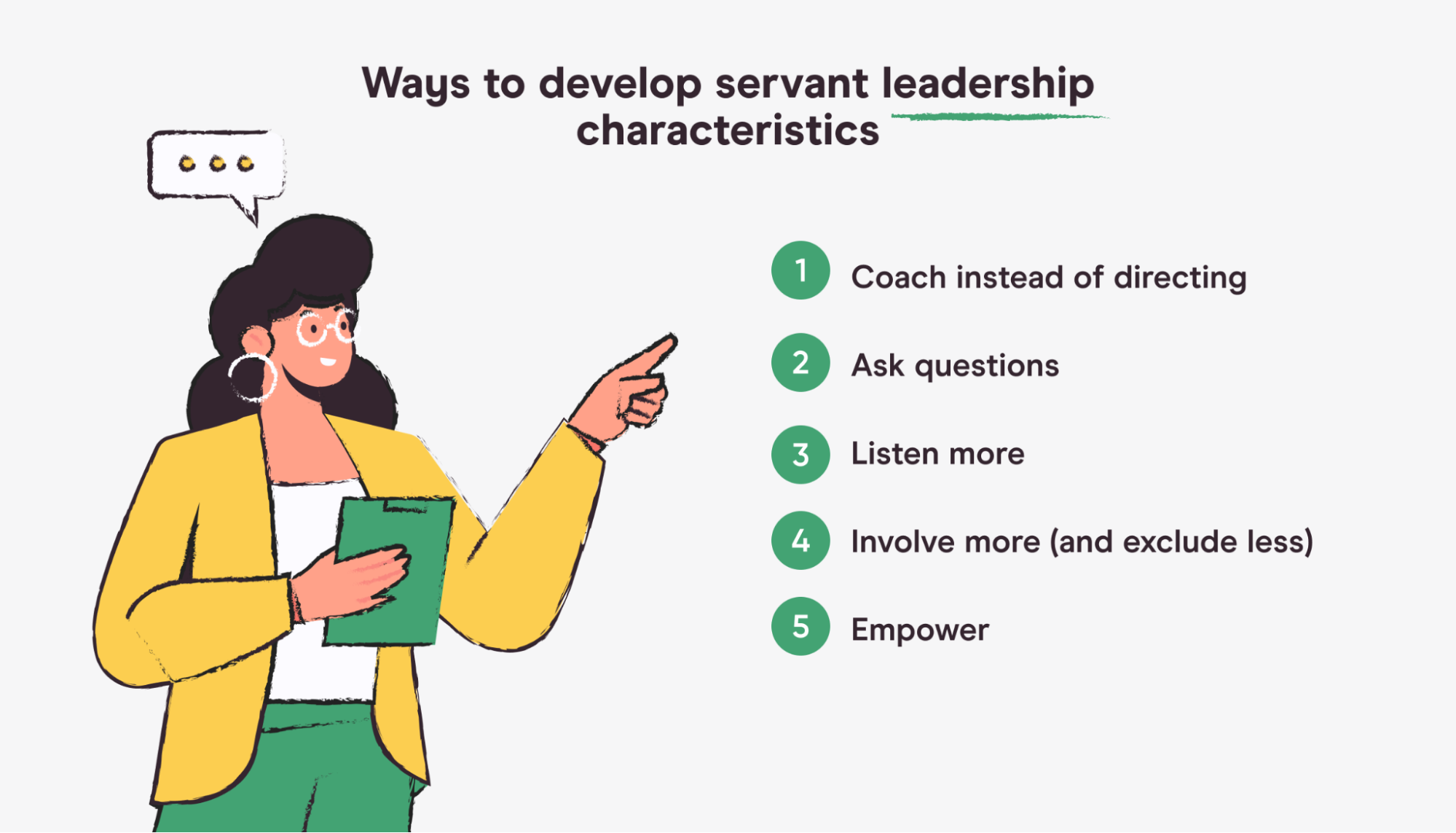Think about the worst boss you’ve ever had.
Perhaps they were dominating, overly critical, or lacking in empathy. Chances are, team morale and productivity were low, and you did not do your best work under their watch.
Now think of the best boss you’ve ever had.
They probably had a vested interest in your and your colleagues’ well-being and growth. Employee engagement and team cohesion were high, and together you achieved great results.
The difference? One was a traditional leader, while the other was a servant leader.
Developing servant leadership characteristics can make you a more effective leader. So let’s dive into what servant leadership is, the 10 servant leader characteristics, and how you can become a servant leader.
What is servant leadership?
Servant leadership is a leadership style that focuses on and prioritizes employee well-being and development. Servant leaders understand that happy, fulfilled employees produce better results for their organization.
Traditionally, a leader was an authoritarian figure who barked orders and paid little interest to their employees’ well-being or professional and personal development.
In 1970, Robert Greenleaf — a retired AT&T executive — turned the stereotype of a traditional leader upside-down with his definition of servant leadership.
Greenleaf believed that great leadership starts with a genuine desire to serve, which leads to a natural aspiration to lead.
He saw the servant leader as someone who concerned themselves with helping their employees become “healthier, wiser, freer, more autonomous, more likely themselves to become servants.”
Greenleaf was a visionary. He understood the impact that servant leadership could have on society by benefitting its least privileged members — the workers.
These days, the concept of servant leadership is well-known in the business world. Personal development and executive coaching have taught us the importance of servant leadership.
Yet many leaders struggle to fully understand the concept, let alone put it into practice — so what exactly is servant leadership?

An organization with a culture of servant leadership prioritizes the needs and well-being of its employees.
It understands the importance of helping them grow both professionally and personally. The servant leader plays an active role in their development, which contributes to better performance.
A servant leader also helps their employees develop their technical skills and advance their careers.
The result is healthy, happy employees who feel supported and taken care of by their leaders.
The benefits for the organization include lower staff turnover, less money lost from absence, and increased productivity and revenue.
Traditional leadership vs. servant leadership
96% of HR professionals agree that employee experience is becoming more important — and leaders have a crucial role to play in ensuring that it’s a positive one.
As leaders start to realize this, servant leadership is growing in importance and popularity.
But what differentiates a servant leader from a traditional leader?
The answer — their priorities.
In traditional leadership models, the priority is to create a good result for the shareholders. Their theory goes that if the shareholders are happy with performance, they will invest more money into the company.
More investments will keep the customers happy, leading to an increase in sales. And when sales increase, the extra revenue can be invested in employee well-being.
This is a pyramidal hierarchical structure that places shareholders at the top and employees at the bottom.
By contrast, a servant leader’s number one priority is their employees. They understand that looking after employee well-being will increase engagement, innovation, and productivity.
This will result in happy customers and increased revenue, which in turn leads to shareholder satisfaction.
In this system, the pyramid is inverted, placing employees at the top and shareholders at the bottom.

10 key servant leadership characteristics
Since employee engagement is a key driver of organizational performance, as a leader, it’s your responsibility to ensure your employees are engaged.
One of the best ways to do this is to develop these 10 servant leadership characteristics:

1. Awareness
Servant leaders are aware of themselves and those around them. This helps them have a holistic perspective on any situation.
Greater awareness can wake you up to reality — and it’s not always a pleasant wake-up call. That’s why the most aware leaders often have a healthy dose of realistic concern.
2. Listening
Decision-making abilities and good verbal communication were once considered the hallmarks of a good leader.
These skills remain relevant today, but the servant leader also understands the importance of listening skills.
Active listening and reflecting back can help you better understand your employees’ needs.
3. Empathy
According to Mercer, empathy — one of the core traits of the servant leader — will be a key business trend for the coming decade.
Empathic listening helps your employees feel heard and understood. A servant leader does not underestimate his or her reports. Instead, they listen with the intention of understanding.
4. Foresight
Foresight is the ability to anticipate the possible outcomes of a decision, action, change, or situation.
It’s a skill that grows with experience and is connected to your intuitive abilities.
While there’s little research in leadership literature regarding foresight, it’s an essential skill for transformational leadership.
It allows you to draw on lessons from the past, analyze the present, and predict the outcomes of future actions and decisions.
5. Conceptualization
The ability to conceptualize a problem or decision means looking beyond the day-to-day and envisioning a hypothetical future.
A servant leader knows how to convey this vision to their team in a way that makes them feel involved and increases employee engagement, commitment, and motivation.
It requires keeping one eye on day-to-day operations while staying focused on the bigger picture.
6. Persuasion
A servant leader doesn’t give orders. Instead, they rely on their powers of persuasion.
This is one of the biggest differences between servant and traditional leadership.
Persuading your team (rather than giving orders) makes you a more effective leader, as you gain more buy-in from them when implementing changes or making decisions.
7. Community-building
A team is a community, and a leader is the one responsible for building that community.
Servant leaders make each team member feel that they form part of something greater than themselves as individuals. This increases their commitment and engagement.
Building a community takes time, and a servant leader must use all the resources available. Once built, they need to maintain the community, including mediating any disputes that arise.
8. Stewardship
Stewardship means making the most of your resources by making sure your employees’ needs are met.
It’s like being a shepherd. You steer your flock away from danger and guide them to green pastures that give them space to grow healthy and strong. Finally, you reap the reward from their milk and wool coats.
A servant leader uses all the available resources to ensure the well-being of their team and, therefore, greater productivity.
9. Healing
Suffering is part of the human condition. And although it may be taboo to talk about personal problems at work, that doesn’t mean they don’t affect performance.
A servant leader knows that a problem employee may be experiencing problems that impact their work and supports them.
This is transformational leadership, and it can help your employees overcome problems and reduce absences and employee turnover.
10. Commitment to the growth of people
A servant leader assumes their responsibility for the personal and professional development of each of their team members and does everything possible to support them in the process.
People have intrinsic value that goes beyond their contribution as employees. Servant leaders understand this and take daily action to help their team members reach their development goals.
Listening to their ideas and letting them participate in decision-making processes helps people grow. Servant leaders also support their direct reports through challenges or new tasks that take them out of their comfort zone.
How to develop servant leadership characteristics
Becoming a servant leader requires a mindset shift from “I” to “we.” It means thinking about how you can serve your team, looking for solutions to their problems, and prioritizing their professional and personal development.
Here are five practical ways to start implementing servant leadership today.

1. Coach instead of directing
When an employee comes to you with a question, don’t tell them immediately what to do.
Instead, ask them what they think they should do. This empowers them to look for solutions, and they may come up with something you hadn’t thought of.
2. Ask questions
Don’t make assumptions about your employees or their work. Always ask plenty of questions to get to the heart of any matter.
3. Listen more
If you’re talking, it means you’re not listening. Listening is the mark of a truly great leader who has the humility to realize they can learn from anyone, including their direct reports.
4. Involve more (and exclude less)
Involving your employees in decision-making processes is crucial for ensuring you take their needs into account.
5. Empower
Micromanaging your employees is disempowering. Trust your direct reports and give them autonomy in their work. This will make them feel empowered.
Will you be a traditional or servant leader?
Servant leadership characteristics can make or break your chances of success as a leader.
Developing them can help you boost employee engagement, leading to less burnout, more motivation, and higher productivity levels.
A great way to start becoming a better leader is to check out Pareto Labs’ courses on management and leadership.

